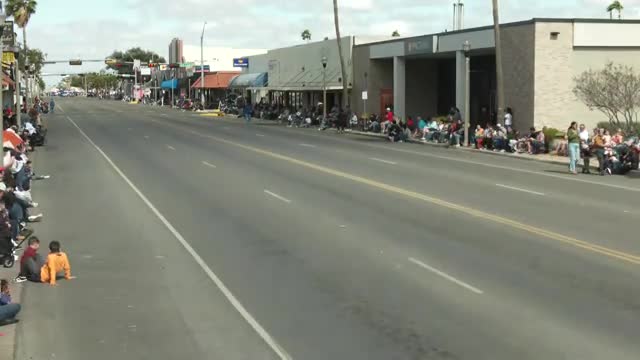Mission holds 93rd Annual Citrus Parade with more than 100 contingents along Conway Street
January 26, 2025 | Mission, Hidalgo County, Texas
This article was created by AI summarizing key points discussed. AI makes mistakes, so for full details and context, please refer to the video of the full meeting. Please report any errors so we can fix them. Report an error »

Mission’s 93rd Annual Citrus Parade took place on Conway Street on an otherwise clear day, the city’s broadcast said, featuring municipal leaders, public-safety units, school bands, community groups and a series of decorative floats.
The parade, which the broadcast said began as a civic celebration in 1932, ran for roughly two miles along Conway Street from the 495 checkpoint to First Street and included what the host identified as 117 contingents. The City of Mission’s Media Relations Department produced the bilingual broadcast on MCC 1300 and on the city’s social channels.
Why it matters: The Citrus Parade is a longstanding local cultural event that commemorates the economic and social role of citrus cultivation in Mission and the surrounding Rio Grande Valley region. It draws municipal officials, school groups and visitors from neighboring towns and remains a focal point for civic celebrations in Mission.
Parade participants named during the broadcast included Mission elected officials and staff in a ceremonial car, uniformed members of the Mission Police and Fire departments, a retired lieutenant who joins as part of the police reserve, the police chief, and representatives from nearby jurisdictions. The broadcast introduced parade royalty, including the queen and king and several duchesses representing citrus-themed titles.
Schools and civic organizations represented included Mission High School (band and cheer), FFA chapters, marching bands from regional high schools and university marching units; the broadcast also noted visitors who traveled from farther away, including a contingent that traveled about 70 miles from Falfurrias. Commercial sponsors and community organizations — from local businesses to auto and lighting specialists — also appeared with floats.
Public-safety presence was prominent in the procession: the broadcast named Police Chief César Torres and acknowledged units from the Mission Police Department, Mission Fire Department, Border Patrol elements and a county precinct. A retired lieutenant, José Antonio García, was identified as participating in the reserve unit that marches in the parade.
The broadcast also highlighted a mounted cadet cavalry unit described on air as a cadet cavalry that participates annually and noted that the parade concludes with a closing festival at the Center for Economic Studies and Development (Centro de Estudios y Desarrollo Económico) at 801 N. Ryan in Mission.
The city thanked volunteers, participants and media partners and closed the bilingual transmission by inviting viewers to the post-parade festival. The broadcast noted that the parade had been suspended once in its history for weather, but otherwise has run annually since 1932.
Ending: Organizers and city officials thanked participants and viewers and encouraged attendance at the festival following the procession; no formal city actions or motions were announced on the broadcast.
The parade, which the broadcast said began as a civic celebration in 1932, ran for roughly two miles along Conway Street from the 495 checkpoint to First Street and included what the host identified as 117 contingents. The City of Mission’s Media Relations Department produced the bilingual broadcast on MCC 1300 and on the city’s social channels.
Why it matters: The Citrus Parade is a longstanding local cultural event that commemorates the economic and social role of citrus cultivation in Mission and the surrounding Rio Grande Valley region. It draws municipal officials, school groups and visitors from neighboring towns and remains a focal point for civic celebrations in Mission.
Parade participants named during the broadcast included Mission elected officials and staff in a ceremonial car, uniformed members of the Mission Police and Fire departments, a retired lieutenant who joins as part of the police reserve, the police chief, and representatives from nearby jurisdictions. The broadcast introduced parade royalty, including the queen and king and several duchesses representing citrus-themed titles.
Schools and civic organizations represented included Mission High School (band and cheer), FFA chapters, marching bands from regional high schools and university marching units; the broadcast also noted visitors who traveled from farther away, including a contingent that traveled about 70 miles from Falfurrias. Commercial sponsors and community organizations — from local businesses to auto and lighting specialists — also appeared with floats.
Public-safety presence was prominent in the procession: the broadcast named Police Chief César Torres and acknowledged units from the Mission Police Department, Mission Fire Department, Border Patrol elements and a county precinct. A retired lieutenant, José Antonio García, was identified as participating in the reserve unit that marches in the parade.
The broadcast also highlighted a mounted cadet cavalry unit described on air as a cadet cavalry that participates annually and noted that the parade concludes with a closing festival at the Center for Economic Studies and Development (Centro de Estudios y Desarrollo Económico) at 801 N. Ryan in Mission.
The city thanked volunteers, participants and media partners and closed the bilingual transmission by inviting viewers to the post-parade festival. The broadcast noted that the parade had been suspended once in its history for weather, but otherwise has run annually since 1932.
Ending: Organizers and city officials thanked participants and viewers and encouraged attendance at the festival following the procession; no formal city actions or motions were announced on the broadcast.
Don't Miss a Word: See the Full Meeting!
Go beyond summaries. Unlock every video, transcript, and key insight with a Founder Membership.
✓
Get instant access to full meeting videos
✓
Search and clip any phrase from complete transcripts
✓
Receive AI-powered summaries & custom alerts
✓
Enjoy lifetime, unrestricted access to government data
30-day money-back guarantee

